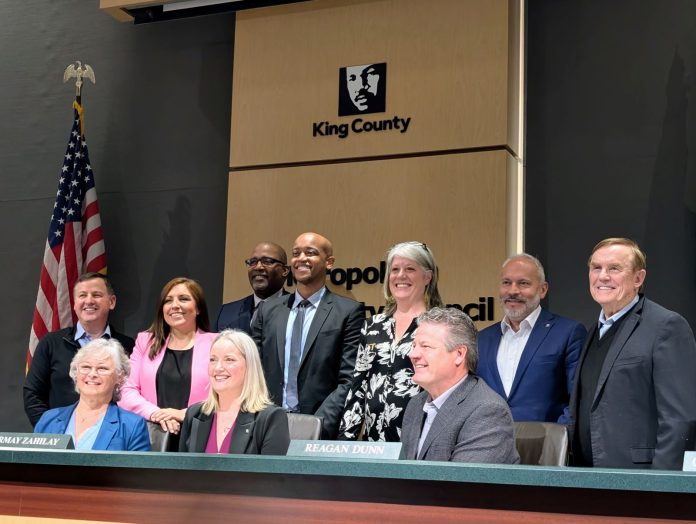
Unincorporated areas of King County have seen minimal multifamily homebuilding activity in the last decade, but that didn’t stop the King County Council from a lengthy debate of school impact fees on Tuesday. County leaders were prompted to alter the school impact fee structure by a state requirement in Senate Bill 5258, which was passed in 2023.
Ultimately, the Council achieved that minimum requirement on Tuesday, but some councilmembers pushed for a broader discussion of reducing fees, rather than simply rebalancing them. Councilmembers passed a set of amendments that fully exempted affordable housing projects and capped the per-unit fees on multifamily buildings at $5,000.
The amount of funding that the County’s school impact fees can provide is likely small, since they are tied to one-time housing permits and dependent on builder interest. Once fees and other building costs get so high that they jeopardize project financials and scare off investors, homebuilders simply don’t build.
Unincorporated areas, where the County Council has jurisdiction and 10% of the county population resides, has seen scant building activity in recent years. Over the last decade, builders have produced about 300 multifamily units and 2,300 single family homes in unincorporated King County, according to County staff.
Within cities, especially King County’s largest, housing activity is much more robust. Seattle has added more than 70,000 homes since 2017. Seattle does not have impact fees for schools or transportation, though the city’s Mandatory Housing Affordability requirement does work much like an impact fee for affordable housing.
Opponents worry impact fees are a NIMBY tool
Some housing advocates have pushed to rein in impact fees because they view them as a backdoor mechanism to obstruct housing, allowing not-in-my-backyard (NIMBY) activists a potent tool to block housing while appearing to have a noble cause. Federal Way has been the poster child for excessive impact fees; it levies a $20,086 impact fee on each new apartment constructed within its borders, while charging much less for each new single family home. The new state law going into effect will force Federal Way to revise that practice, it would appear.
For example, Federal Way famously imposed impact fees of $20,086 per units on multifamily units, while levying much lower fees on new single family homes. Pretty clearly seemed intent on reducing apartment development. www.theurbanist.org/2019/05/21/o…
— The Urbanist (@theurbanist.org) August 26, 2025 at 2:38 PM
[image or embed]
Amy Enbysk, press secretary for King County Executive Shannon Braddock, said the Executive’s goal was to comply while maintaining the funding source for local school districts.
“This Ordinance was drafted in response to legislation recently passed by the State (SB5258), which requires counties to change how impact fees are calculated, with the goal that smaller residences would have a lower impact fee than larger residences,” Enbysk said.
As the proposal advanced, Councilmember Teresa Mosqueda pushed for a broader analysis of the impact on builders, addressing the risk of blocking housing construction. Ultimately, Mosqueda viewed the proposal as falling short of the mark and she proposed three amendments intended to reduce that risk.
“When the proposal was presented in the Land Use Committee in July, I was concerned that there was no analysis of how the impact fee proposal would impact the feasibility of badly-needed housing in the County. My concern was that, without proper calibration, fees could actually disincentivize the building of more family sized multifamily units in particular,” Mosqueda wrote in her newsletter. “This is especially concerning given that school districts are reporting decreased enrollment as families are being pushed out of our communities due to a lack of affordable and family-sized units across the region. When there aren’t enough options for families to live in our communities, they leave (often leaving the state altogether), and schools suffer along with our community as a whole.”
Some housing advocates are worried impact fees would stunt homebuilding and are ill-timed. @cmtmosqueda.bsky.social has proposed guardrails: -Amendment 2: caps fees on family-sized units -Amendment 3: exempts affordable housing projects -Amendment 4: expands reqs around housing impacts analysis
— The Urbanist (@theurbanist.org) August 26, 2025 at 1:42 PM
Mosqueda’s amendments garnered support from organized labor and builders, including LIUNA, Seattle Building Trades, MLK Labor, Housing Development Consortium, McCullough Hill Leary, School Board Members, Habitat for Humanity, and the White Center CDA.
County caps impact fees at $5,000 per unit
State lawmakers’ goal with SB 5258 appears to have been preventing undue burdens on multifamily builders. Some jurisdiction heap more impact fees on apartments than single family homes, or apply the same fees to small efficiencies, microhousing, or backyard cottages as units many times larger.
On the other hand, Mosqueda pointed to scarcity of multi-bedroom apartments as another policy issue worthy of addressing. As a result, she pushed an amendment capping fees on multi-bedroom multifamily units.
Councilmember Rod Dembowski proposed to expand that $5,000 cap to all multifamily units. Mosqueda and most of her colleagues backed that change. One exception was Councilmember Claudia Balducci, who argued for a fuller analysis and engagement process with school officials before advancing a cap on fees. Balducci ultimately voted for the underlying bill.
With the fee restructure and cap and affordable housing exemption, Dembowski argued the legislation marked one of the rare times in his 12 years on the County Council that they were lessening obstacles to permitting housing rather than adding them.
“The high cost of housing is driven in part by the high cost to build it. Excessive impact fees, many approaching $20,000 per unit, unreasonably increase housing costs and reduce access. I have raised these concerns for years, and so was happy to join with Councilmember Mosqueda to address this issue by revising the impact fee formula,” Dembowski said in a statement. “The new formula strikes a reasonable balance that ensures new development helps cover the cost of new schools, while recognizing that fees cannot be so burdensome that housing is not accessible and affordable. This bold action sends a strong signal that King County is serious about taking action to implement the recommendations in the Regional Affordable Housing Task Force Report and cut the cost to build new homes.”
Through her spokesperson, Braddock declined to back the amendments outright, indicating the Executive Office would evaluate them caps and exemptions in partnership with school districts and builders.
“We look forward to working with both schools and housing providers through the evaluation process, including reviewing caps and exemptions,” Enbysk said.
School districts face varied problems
Unincorporated areas largely fall in eastern King County in exurban districts like Councilmember Sarah Perry’s District 3 and Councilmember Reagan Dunn’s District 9. Washington State’s growth management framework would encourage tapping the brakes on growth in these exurban areas. However, some unincorporated urban areas also exist, such as White Center in Mosqueda’s District 8 and Skyway in Council Chair Girmay Zahilay’s District 2.

The problems facing school districts also vary across King County. Some suburban school districts are overcapacity, having failed to expand enough to serve their local growth spurt. On the other hand, some urban school districts like Seattle Public Schools is under-enrolled, as family sizes have shrank since postwar peaks and a growing number of parents have placed their kids in private schools.
“Snoqualmie Valley School District is 35% overcapacity. North Shore, which I share with Councilmember Dembowski, is overcapacity and expected to be significantly overcapacity,” Perry said. “But that is not true for Seattle. That is not true for other school districts.”
Time will tell whether the impact fee legislation can be any help for schools grappling with too much enrollment, whether by slowing down growth or raking in fees or some combination of the two. Impact fees can only be used to expand school facilities, not to pay for maintenance or operations in existing schools.
Balducci offered the opinion that impact fee legislation was too around the margins to swing the calculus much either way for either builders or school district administrators.
“I also understand that the impacts are probably fairly minimal on both sides of the aisle,” Balducci said Tuesday. “The schools lose a minimal amount of fees . […] And the cut to the cost of funding housing are minimal. I mean, I think we’re talking about a few thousand dollars for a construction project that’s going to cost hundreds of thousands of dollars.”
Going forward, Balducci suggested an approach where impact fees are deployed in school districts that are significantly overcapacity, while other areas perhaps avoid them.
“I would absolutely support a coordinated approach going forward, to try to find a way to strike this balance between impact fees that support school districts — not like the ones in my district — like the ones in Councilmember Perry’s district, that are bursting at the seams,” Balducci said. “They’re the ones that really need to build. They already have more kids than they can then they can support. And so if we incentivize more kids coming there, that’s not the answer to their particular problem.”
Doug Trumm is publisher of The Urbanist. An Urbanist writer since 2015, he dreams of pedestrian streets, bus lanes, and a mass-timber building spree to end our housing crisis. He graduated from the Evans School of Public Policy and Governance at the University of Washington in 2019. He lives in Seattle's Fremont neighborhood and loves to explore the city by foot and by bike.

